

NASA invites public to vote on name for Mars 2020 rover. NASA has announced the nine finalists for the name of the space agency’s next Mars rover — scheduled for launch in July — and invited the public to vote on the candidates before making a final selection in the coming months.

A panel of volunteer judges, including educators, professionals and space enthusiasts around the United States, selected 155 semifinalists after evaluating more than 28,000 submissions in NASA’s “Name the Rover” essay contest open to U.S. students in kindergarten through 12th grade. NASA winnowed down the list to nine finalists and announced the prospective names Tuesday. According to NASA, the nine finalists (submission name, grade level, student name and state) are: NASA's exoplanet-hunting mission catches a natural comet outburst in unprecedented detail. Using data from NASA's Transiting Exoplanet Survey Satellite (TESS), astronomers at the University of Maryland (UMD), in College Park, Maryland, have captured a clear start-to-finish image sequence of an explosive emission of dust, ice and gases during the close approach of comet 46P/Wirtanen in late 2018.
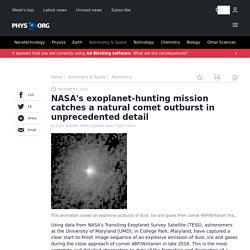
This is the most complete and detailed observation to date of the formation and dissipation of a naturally-occurring comet outburst. The team members reported their results in the November 22 issue of The Astrophysical Journal Letters. "TESS spends nearly a month at a time imaging one portion of the sky. With no day or night breaks and no atmospheric interference, we have a very uniform, long-duration set of observations," said Tony Farnham, a research scientist in the UMD Department of Astronomy and the lead author of the research paper.
"As comets orbit the Sun, they can pass through TESS' field of view. NASA will launch a ‘robot hotel’ to the Space Station on its next SpaceX resupply mission. NASA is going to be sending something it calls a “robot hotel” to the International Space Station aboard the next commercial resupply mission, which is set to launch aboard a SpaceX Falcon 9 rocket this week.
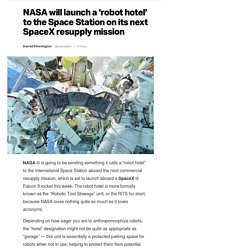
The robot hotel is more formally known as the “Robotic Tool Stowage” unit, or the RiTS for short, because NASA loves nothing quite so much as it loves acronyms. Depending on how eager you are to anthropomorphize robots, the “hotel” designation might not be quite as appropriate as “garage” — this unit is essentially a protected parking space for robots when not in use, helping to protect them from potential dangers presented by being in space, including exposure to radiation, and the potential to get hit by micrometeors and other debris. The first guests at the hotel will be two robots called Robotic External Leak Locators (RELL — because acronyms). They do what it says on the tin, finding leaks in the ISS exterior hull from the outside, which is a key job.
Old NASA Moon Orbiter Finds New Life for Artemis Lunar Landing Project. NASA has a serious case of lunar fever, with an ambitious goal to land humans on the moon in 2024.
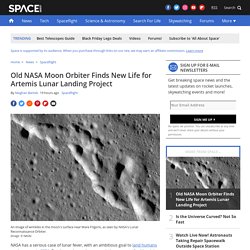
But those plans rely on an existing spacecraft with origins dating back to NASA's last moon-mission dreams. NASA's Lunar Reconnaissance Orbiter launched in 2009 and has been studying the moon ever since. Originally, the mission was just the first of a suite of lunar missions, designed to find places for humans to land on the moon. But LRO was launched with plans to be reclassified as a science mission one year in, and as that happened, NASA's interest in sending astronauts to the moon happened to wane as well. Nine years later, NASA is ready to comb through the mission's data for possible human landing sites after all. "There's this renewed interest in LRO and this renewed interest in what we can do," Noah Petro, NASA's Lunar Reconnaissance Orbiter project scientist, told Space.com.
NASA Finds India’s Vikram Moon Lander Crash Site, With Amateur’s Help. NASA has found pieces of Vikram, a small spacecraft that India attempted to land on the moon in September.
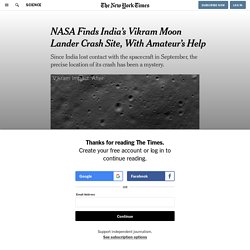
They did it with the help of an engineer from India who scoured the lunar surface in his spare time. Vikram was part of India’s Chandrayaan-2 mission to the moon, which launched in July. If the spacecraft had reached the surface in one piece on Sept. 7, India would have been only the fourth country to successfully put a lander on the moon. But less than two miles above the surface, Vikram veered from the planned descent trajectory and fell out of radio contact. Choice page. Something Strange Sends Tech Haywire at Earth's Poles, And NASA Wants to Know More. If you venture too close to one of Earth's poles, you'll notice something rather strange happening to any gadgets using radio waves, satellite connections, or GPS.

Now, NASA is on a mission to find out why. Well, three missions to be exact. NASA is backing a range of initiatives to investigate the northern polar cusp, a funnel in space that's thought to be behind some of the weird space phenomena happening above the poles. This funnel, and the matching one at the South Pole, allows solar winds from the Sun to get right down to Earth's atmosphere – in other words, here the solar winds aren't reflected back out into space by the Earth's magnetic field, as they are across the rest of the planet. NASA Supercomputer Simulates the Weather on Mars. The Martian atmosphere is a lot different than Earth’s.
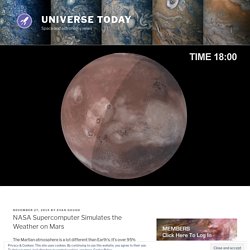
It’s over 95% carbon dioxide, and contains only trace amounts of oxygen and water vapor. But that trace amount of water vapor still plays a pronounced role in the climate. NASA is very interested in Mars’ atmosphere, weather, and climate. The more they know about Mars, the more effectively they can plan missions. And understanding present day Mars can help us understand the history of the Solar System, how planets evolve, and what Mars’ climate was like in the ancient past. NASA Wants to Book a Seat on a Short Private Mission to the Space Station. NASA is interested in expanding its astronauts' options in low-Earth orbit.
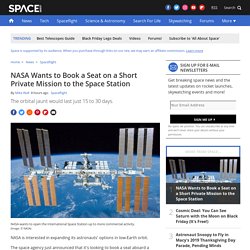
The space agency just announced that it's looking to book a seat aboard a privately organized mission to the International Space Station (ISS) sometime in the next five years. And this mission would be brief, lasting just 15 to 30 days rather than six months, which is the current norm for crewmembers on the orbiting lab. Invites Media to SpaceX In-Flight Abort Test for Commercial Crew. - Are you a robot? NASA’s space pallet concept could land rovers on the moon cheaply and simply. Establishing an enduring presence on the Moon will mean making a lot of landings — and NASA researchers want to make those landings as reliable and cheap as possible.
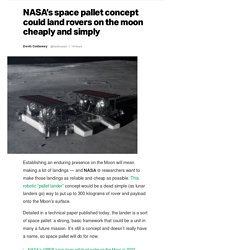
This robotic “pallet lander” concept would be a dead simple (as lunar landers go) way to put up to 300 kilograms of rover and payload onto the Moon’s surface. Detailed in a technical paper published today, the lander is a sort of space pallet: a strong, basic framework that could be a unit in many a future mission. It’s still a concept and doesn’t really have a name, so space pallet will do for now. NASA finds sugar in meteorites that crashed to Earth. An international team of scientists found "bio-essential" sugars in meteorites, which also contain other biologically important compounds, according to a press release from NASA on Tuesday.

Asteroids -- rocky near-Earth objects which orbit the sun -- are the parent bodies of most meteorites. And the theory suggests that chemical reactions within asteroids can create some of the elements essential to life. In a study published Monday in the Proceedings of the National Academy of Sciences, researchers analyzed three meteorites, including one that landed in Australia in 1969 and dates back billions of years. Previous studies have also tried to investigate the meteors for sugar -- but this time, researchers used a different extraction method using hydrochloric acid and water.
The researchers found sugars like arabinose and xylose -- but the most significant finding was ribose. Ribose plays a hugely important part in our human biology. NASA Eyes a New Moon Rover for Astronauts and Robot Lunar Explorers. HOUSTON — NASA is considering developing an unpressurized rover that astronauts could drive remotely on the moon alongside a suite of robotic lunar explorers as part of the Artemis program. In a speech Wednesday (Nov. 20) here at SpaceCom Expo, a two-day conference covering the business of space, Tom Cremins, NASA's associate administrator for strategy and plans,said such a project would be a public-private partnership that could include involvement from companies with expertise in making golf carts, all-terrain vehicles, automobiles or even autonomous mining parts.
Similar rovers could be used in future crewed Mars missions as well. Cremins said he would like the rover ready to operate "when the first crews arrive" (which NASA hopes will be in 2024) and allow for astronauts to operate it remotely from as far away as the planned Gateway station in lunar orbit. This rover would be used "to conduct operations and to add to the science objectives," he said. NASA Finds Supermassive Black Hole Birthing Stars at “Furious Rate” Galaxy clusters have been fascinating astronomers for decades. Often consisting of thousands of galaxies, the clusters are the largest known structures being held together by gravitational forces.
At their centers, astronomers have found some of the biggest and most powerful black holes ever discovered, and high-energy jets of extremely hot particles emanating from these black holes were found to be preventing the formation of stars — which, of course, raised a galactic mystery: where are all the stars coming from? But now, thanks to data collected by NASA’s Chandra X-ray Observatory and the Hubble Space Telescope, a team of scientists has found that a galaxy cluster called the Phoenix Cluster, some 5.8 billion light years from Earth, is birthing stars at a “furious rate.” Its black hole seemed to be far weaker than other clusters’ black holes, with trillions of Suns’ masses worth of hot gas cooling around it, allowing the formation of a vast number of stars.
NASA Says It Found Building Blocks of Life in Fallen Meteorites. Raining Down A team of scientists says it’s found sugar molecules — crucial to the development of life on Earth — in two different fallen meteorites. The discovery suggests that meteor impacts may have delivered the sugars to Earth, per a NASA press release. One of the sugars is the RNA component ribose, a key biological building block, and the discovery that it may have come from space complicates our understanding of how life emerged.
Eliminating Alternatives The scientists, who hail from NASA and a trio of Japanese universities, took extra steps to make sure they didn’t just contaminate their samples. The team hopes to double check by searching for ribose in pristine samples from space rocks, like those taken from the asteroid Ryugu that are currently en route to Earth. NASA detects water vapor on Jupiter’s moon Europa. An international research team led by NASA’s Goddard Space Flight Center in Maryland has, for the first time, detected water vapor above the surface of Jupiter’s moon Europa. Using the W.
M. Keck Observatory in Hawaii, scientists were able to measure the water vapor. “Confirming that water vapor is present above Europa helps scientists better understand the inner workings of the moon,” said NASA, in a statement released Monday. “For example, it helps support an idea, of which scientists are confident, that there’s a liquid water ocean, possibly twice as big as Earth’s, sloshing beneath this moon’s miles-thick ice shell.” NASA told to get act together on commercial crew vendors as chance of American-free ISS rises.
Auditors minced no words in their assessment (PDF) of NASA's Commercial Crew providers: overdue, overbudget and overpaid. This was not supposed to have happened. SpaceX and Boeing should have been flying crew to the International Space Station by now thanks to fixed-price contracts. Or not so fixed, as the inspectors observed: "NASA agreed to pay an additional $287.2m above Boeing's fixed prices to mitigate a perceived 18-month gap in ISS flights anticipated in 2019 for the company's third through sixth crewed missions. " The space agency has had to admit that the US presence on the multibillion-dollar orbiting lab is likely to drop to a single crew member in 2020. NASA Has Detected Weird Orbital Movement From Two of Neptune's Moons. Life isn't always easy for astrophysicists: just when they've figured out another aspect of the patterns of movement in our Solar System, along come two of the moons of Neptune to mess everything up.
Compared with Thalassa, Naiad's orbit is tilted by about five degrees – it spends half of its time above Thalassa and half of it below, in a linked orbit that's unlike anything else on record. "We refer to this repeating pattern as a resonance," says physicist Marina Brozovic, from the NASA Jet Propulsion Laboratory. "There are many different types of dances that planets, moons and asteroids can follow, but this one has never been seen before. " Nasa-sls-megarocket-engines-ready-for-moon. NASA finds Neptune moons locked in 'dance of avoidance' Even by the wild standards of the outer solar system, the strange orbits that carry Neptune's two innermost moons are unprecedented, according to newly published research.
NASA finds Neptune moons locked in 'dance of avoidance' NASA's Curiosity rover makes a baffling oxygen discovery on Mars. Hubble Spots a Curious Spiral. The universe is simply so vast that it can be difficult to maintain a sense of scale. NASA finds Neptune moons locked in 'dance of avoidance' NASA Reverses Course After Giving Asteroid Nazi Name. Ultima Oops It’s the furthest celestial object we’ve ever visited with a spacecraft — asteroid Ultima Thule has been fascinating scientists ever since NASA’s New Horizons spacecraft visited it last winter.
NASA Scientists Detect Huge Thermonuclear Blast Deep in Space. NASA Scientist Shows Dinosaurs Roamed Earth on The Other Side of The Milky Way. NASA Scientists Detect Huge Thermonuclear Blast Deep in Space. Sciencealert. When dinosaurs ruled the Earth, the planet was on a completely different side of the galaxy. A new animation by NASA scientist Jessie Christiansen shows just how long the dinosaurs' reign lasted, and how short the era of humans has been in comparison, by tracing our solar system's movement through the Milky Way.
Our Sun orbits the galaxy's centre, completing its rotation every 250 million years or so. NASA does not deny the “over $2 billion” cost of a single SLS launch. Boeing Just Sent NASA Its Moon Lander Idea for Artemis Astronauts. Here It Is. NASA opens untouched Apollo moon rock sample for first time in 40 years. - Are you a robot? Unimaginable View of Milky Way From Year of Observations by NASA TESS – 29 Exoplanets Discovered. Eu.usatoday. Boeing submits Artemis lunar lander proposal to NASA. NASA rejects Blue Origin’s offer of a cheaper upper stage for the SLS rocket. Hubble observes an alien visitor: the comet 2I/Borisov. How the Pirates, Nasa's innovative and... - MIT Sloan Management Review. Europe’s Mars lander parachute problems may be worse than thought.
NASA Is Moving Forward With Space-Based Mission to Hunt for Hazardous Asteroids. Visualization Shows a Black Hole’s Warped World. Lockheed Wins the Contract to Build Six More Orion Capsules. NASA Wants to Send Nuclear Rockets to the Moon and Mars. Eu.usatoday. NASA news: Black hole 2.6 billion times heavier than Sun is hidden in this Hubble photo. NASA launches a new planet-hunting telescope using a giant balloon. Danger: Move to Mars before it's too late, warns space expert - Earth's in danger. NASA news: Incredible black hole appears on Jupiter - What is it? NASA is now officially accepting proposals for landers to take people to the Moon. NASA releases sounds of Mars quake picked up by InSight lander.
Mars Is Heaven! NASA chief scientist says 'we're close' to making announcements about life on Mars. Black hole: NASA captures a black hole tearing a star to shreds in first-ever discovery. NASA news: A black hole sleeping giant is hidden in this photo - Can you find it? Asteroid alert: NASA tracks HUGE ‘near Earth object’ approaching Earth at 38,000mph. Asteroid News: What NASA got wrong about God of Chaos Apophis asteroid exposed. Hubble Finds Medusa in the Sky. , CERN Technology Advances Miniaturized Radiation Detection. Why Elon Musk's Big, Shiny Starship Sparked a Passive-Aggressive Fight with NASA. , CERN Technology Advances Miniaturized Radiation Detection. Intuitive Machines, NASA's Hired Ride to the Moon, Aims for 2021 Lunar Landing. Not long ago, the center of the Milky Way exploded. NASA news: Scientist asks 'was Einstein wrong?' after object breaks laws of physics.
NASA news: Space agency warns of a swarm of asteroids hurtling towards Earth. 's Curiosity Rover Finds an Ancient Oasis on Mars. NASA may ask SpaceX to extend duration of Crew Dragon test flight. Why NASA's Annoyed About Elon Musk's Giant Rocket. NASA looks to support development of commercial space stations. Asteroid news: NASA-tracked rock will come as close as Moon tonight - Will it hit?
Pressure Runs High at Solar System's Edge. Asteroid news: NASA tracks three rocks flying past Earth - One was found four days ago. NASA news: Hubble snaps Medusa galaxy consuming smaller star cluster - Hubble pictures. Invites Media to Events Highlighting Spacesuits for Moon to Mars. NASA Artemis spacesuits could mean the end of astronaut moon bloopers. NASA engineer's 'helical engine' may violate the laws of physics. A NASA image shows the center of our galaxy in unprecedented detail. Expect far more revealing photos from a soon-to-launch telescope.
Right Again, Einstein! Wobbling Pulsar Confirms General Relativity. Dying Star's Colorful Demise Captured by Hubble Telescope. Video appears to show SpaceX's new spaceship for NASA exploding during a safety test. SpaceX likely to win NASA’s crew competition by months, for billions less – Ars Technica.
NASA Discovers a Pulsar Shot Out of a Supernova at 2.5 Million MPH. Nasa observatory programs. NASA Discovers Hidden Portals In Earth’s Magnetic Field. A NASA Engineer Wants to Use a Particle Accelerator to Power Rockets. NASA: Four Astronauts Will Stay on the Moon For Two Weeks. Hubble Views a Not-So-Lonely Galaxy. NASA eyes Pluto mission. NASA: Four Astronauts Will Stay on the Moon For Two Weeks. NASA shares details of lunar surface missions—and they’re pretty cool.
's Latest Exoplanet Posters Are a Halloween Treat. NASA should shed lesser priorities to achieve a 2024 moon landing. The self-hammering probe on NASA’s Mars lander can’t seem to actually dig into the ground. NASA shares image of the sun resembling a jack-o’-lantern. NASA: US will need water to return to moon.
See NASA's Mars 2020 rover stand on its own legs for the first time. See NASA's Mars 2020 rover stand on its own legs for the first time. A Mega-Cluster of Galaxies in the Making. NASA’s VIPER lunar rover will hunt water on the Moon in 2022.